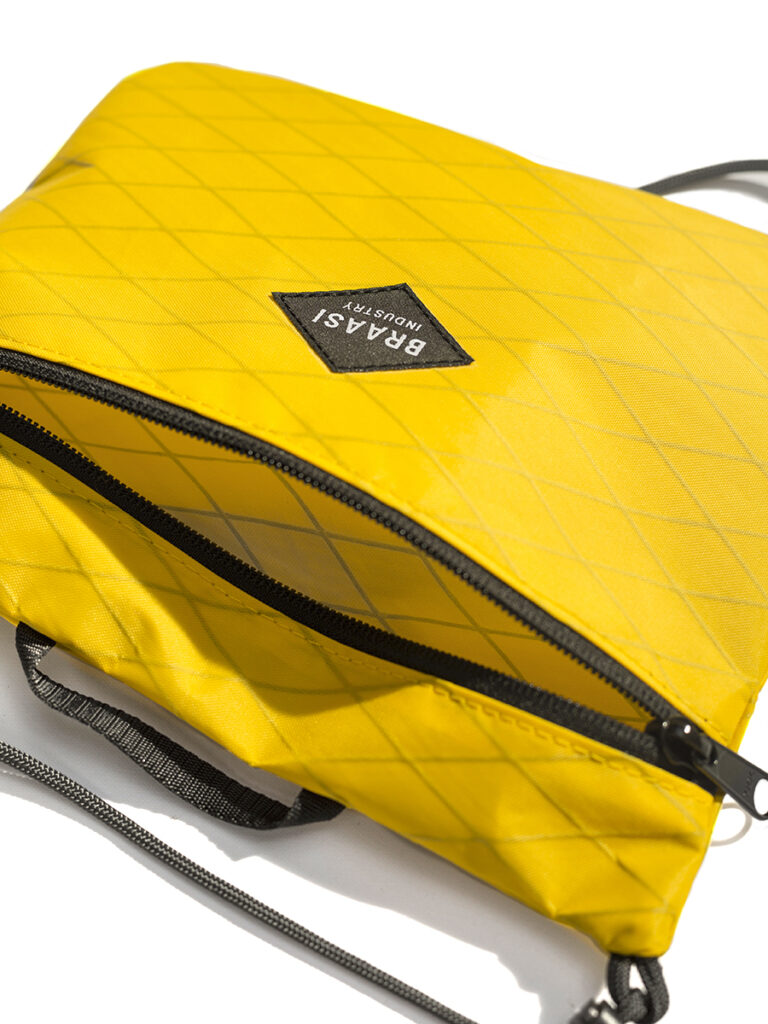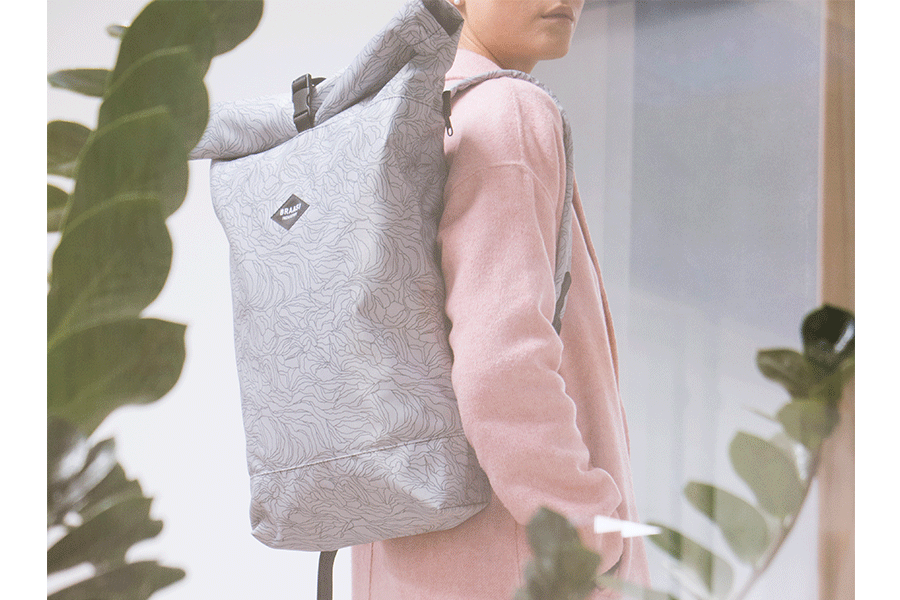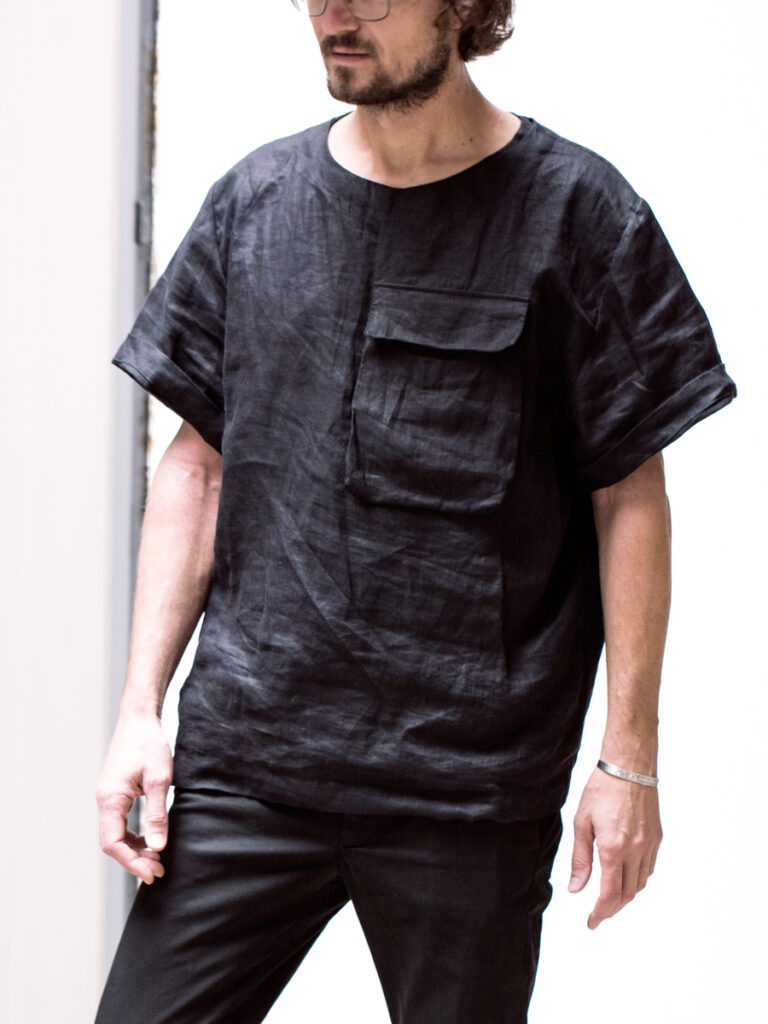What are our products made of?

MATERIALS
We choose our materials very carefully. We consider it to be one of the most important parts of the whole process because it reflects not only the quality and sustainability of our products but also environmental and social responsibility.
Customer satisfaction is our number one focus.
We primarily source our materials and components from Czech manufacturers to support our local community of businesses.
Braasi backpacks are made from two materials:
- Cordura (nylon fiber)
- or cotton canvas (tent fabric), which we combine with leather.
Each backpack has a waterproof lining with two to three small inside pockets. The color of the lining is chosen separately for each type of backpack and we purposefully use bright colors on the inside so that items in the bag can be found easily.
MATERIALS ORIGIN
Most of our materials are produced in the Czech Republic.
Outer fabrics, linings, straps, foams and our Braasi labels are purchased from Czech manufacturers.
A Japanese company YKK® supplies us with buckles and zippers and an Italian tannery from the Veneto region supplies us with full grain leather.
CORDURA® 1100D, 500D
Cordura is a material made of certified nylon fiber, from the company Invista (formerly Dupont). These fibers are then woven.
Our Cordura is made in the Czech Republic or Germany.
It is a synthetic material with high tear or abrasion resistance and it is often used in the army or for sports equipment. It is slightly reflective.
The term 1100D means 1100 denier, which is a unit of length density that describes the weight in grams per 9000 meters of material.
Cordura backpacks have a more outdoorsy look. They’re very easy to take care off and are suitable for hand washing.
The outside layer and lining are both water resistant. These two layers will keep your personal belongings safe and dry.
For even greater water resistance, an impregnating spray can be applied to the backpack’s surface.
Backpacks made from Cordura® have many color combination possibilities.
When sewing our backpacks we do not combine Cordura® with leather since Cordura® is colorfast, while the leather acquires a patina over time just like the cotton.
We use Cordura® for: all of our shoulder straps; backpacks in category Basic and Explorer&Traveler; pouches; crossbody and baby collection as well.

X-PAC®
X-Pac® is a unique 100% waterproof fabric, which was originally created as an innovative material for sailboat sails.
Sails designed for yacht racing are made to withstand extreme tension, extreme coastal weather, humidity and salt. That’s why X-Pac® is so durable.
In general, it is a composite fabric laminated from several layers: an upper nylon fabric (210D), an X-PLY grid made of polyester, a waterproof coating and a lower polyester fabric with a waterproof layer. The grid also determines the structure of the fabric, that’s why it has a visible diamond pattern on the surface.
X-Pac® is also super light (it’s the lightest fabric we work with) and very flexible. In our workshop we work with types WX21 and LS21.
We use X-PAC® for: backpacks in category x-pac.


COTTON CANVAS
We combine cotton and leather on backpacks for a more elegant look.
These materials go hand in hand because they both change appearance over time and this way they can age together. Overall, they compliment each other beautifully.
Great examples of this are our Ayo and Haak models.
Our Canvas collection (Henry canvas, Noir and Nico, Canvas bag, Levo canvas, or Rolltop canvas) are designs that simply radiate elegance.
Even with the natural materials you can be sure that your personal belongings will stay dry, thanks to the water resistant inner lining. For even better water resistance this material can also be spray impregnated.
If you’re looking for both elegance and functionality, cotton is the answer.
LEATHER
Braasi’s philosophy is to always bring the best quality product to our customers, therefore we try our best to choose top quality materials. In order to find the best quality leather we decided to visit the Mecca of tanning in Northern Italy.
We took our time and toured several tanning companies. Finally we have chosen the leather maker in the area of Veneta. Our supplier treats the animals with respect, complies with all laws and regulations as well as environmental sustainability. Our leather originates from cows that are raised for meat, so the skin is not the primary raw material. Due to the further use the leather does not end up in the waste.
We choose the so- called aniline leather, the top full grain quality. It is processed by dipping into natural oils. This method does not dye it only on the surface, but throughout the entire leather thickness. Thanks to this treatment the leather retains its natural lines and uneven color. It remains flexible, abrasion resistant, ending with a beautiful silky appearance. With time and wear it gains a beautiful patina.
CARE LEATHER:
Avoid placing leather near direct sunlight.
Keep the leather away from heat sources.
Dust regularly with a soft and dry cloth.
Never use household cleaning agents, furniture polishes, ammonia, bleach, varnish, oils or similar.
If a spill should occur, blot immediately with a clean absorbent cloth or sponge.
Do NOT rub the spot with force or pressure.
If you wish to use specifically made creams or lotions for leather upkeep and care feel please consult specialised companies and leather professionals who supply such sets. If you need recommendations on who to consult, we are happy to indicate.
BACKPACKS WITH PRINTED FABRIC
Collaboration often brings great things.
We find working with different designers and artists meaningful and inspiring.
They create wonderful, unique designs for our limited editions. The Paperjoe or Maappi models are great examples of these projects.
Our printed backpacks are made of polyester.
The Printing is created by a special technique called sublimation printing, where at a temperature of 200 °C the print is incorporated directly into the fibers of the fabric.
This material can also be treated with an impregnating spray but thanks to the waterproof lining, your things stay dry even without additional treatment.


PARACHUTE
The non-traditional material of parachute fabric gives a delicate look to our sportier designs.
It is water repellent, flexible, easy to shape, ultra light and gives of a soft shine.
We use newly made materials from Czech manufacturers as well as recycled parachutes that have been discarded. Since the quality of the fabric is still excellent, it would be a shame to throw it away.
We do not recommend washing parachute material in the washing machine but it is easy to keep clean by hand-washing in soapy water.
To see how cool this unconventional fabric looks on our items, check out our Anorak windbreakers, Georgina bags or the ultra light and flexible Mika.
TYVEK®
Tyvek® is a membranal, waterproof, 100% recyclable material.
It consists of layered polyethylene (HDPE) and is produced in Luxemburg.
This material is used in construction as insolation against water or in protective clothing.
You might have come across this material in the form of wristbands used at parties and festivals and noticed it is nearly impossible to rip.
It may not look strong but polyethylene nonwoven fabric is very durable material.
Products made with Tyvek® acquire a unique pattern just like paper but its integrity remains intact.
Tyvek® can be printed or even drawn on.
It is impermeable to water and can easily be kept clean with a soapy sponge or a gentle program in the washing machine.
Our Sacoche crossbody bags, cosmetic bags and snack bags are made from Tyvek® .


LINEN
Throughout history, linen was gradually replaced by cotton and has slowly disappeared from the market but in recent years this material has returned to the forefront of interest, not only in the fashion industry.
One of the reasons for this comeback is the growing effort to greener production.
Growing flax requires half as much water as growing cotton and thanks to its greater resistance to weeds, it needs one fifth of the pesticides.
It is simply the fabric of the future.
You can buy a Braasi linen T-shirt here.
WOOL
Our woolen products are purchased from a Lithuanian family’s knitting mill.
We personally met the company owner at a Design Week in Helsinki. She pays great attention to selecting the highest quality wool. We were instantly fascinated by her work.
There can be astounding differences in the quality of various wools. Maija knits hats made of merino lamb wool which is much softer than wool from fully grown sheep because it’s collected when the sheep are only seven months old.





